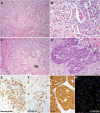Sinonasal Secretory Carcinoma of Salivary Gland with High Grade Transformation: A Case Report of this Under-Recognized Diagnostic Entity with Prognostic and Therapeutic Implications
- PMID: 28980201
- PMCID: PMC5953877
- DOI: 10.1007/s12105-017-0855-5
Sinonasal Secretory Carcinoma of Salivary Gland with High Grade Transformation: A Case Report of this Under-Recognized Diagnostic Entity with Prognostic and Therapeutic Implications
Abstract
Secretory carcinoma (SC) is a recently described salivary gland carcinoma with characteristic ETV6-NTRK3 fusion. In this case report, we described a SC of the maxillary sinus that underwent high grade transformation in a 61-year-old patient. The diagnosis was confirmed by the presence of ETV6 translocation. Within the sinonasal tract, SC is an important differential diagnosis especially of sinonasal adenocarcinoma, non-intestinal type (non-ITAC), as these two entities bears histologic and immunophenotypic similarity. Distinction between these two tumors can be challenging based on the morphology alone and may require additional immunohistochemical and molecular studies. It is important to recognize that SC can occur in the sinonasal tract as correctly diagnosing SC may be prognostic relevant and may provide new targeted therapeutic avenues for these patients.
Keywords: ETV6-NTRK3 fusion; High grade transformation; Secretory carcinoma; Sinonasal non-intestinal type adenocarcinoma.
Conflict of interest statement
Conflict of interest
All authors declare that he/she has no conflict of interest.
Ethical Approval
All procedures performed in studies involving human participants were in accordance with the ethical standards of the institutional and/or national research committee and with the 1964 Helsinki declaration and its later amendments or comparable ethical standards.
Informed Consent
Informed consent was obtained from all individual participants included in the study.
Figures

References
-
- El-Naggar AK, Chan JKC, Grandis JR, Takata T, Slootweg PJ. World Health Organization classification of tumours: pathology and genetics of head and neck tumours. 4. Lyon: IARC Press; 2017.
-
- Skalova A, Vanecek T, Sima R, Laco J, Weinreb I, Perez-Ordonez B, et al. Mammary analogue secretory carcinoma of salivary glands, containing the ETV6-NTRK3 fusion gene: a hitherto undescribed salivary gland tumor entity. Am J Surg Pathol. 2010;34(5):599–608. - PubMed
-
- Bhayani MK, Yilmaz T, Sweeney A, Calzada G, Roberts DB, Levine NB, et al. Sinonasal adenocarcinoma: a 16-year experience at a single institution. Head Neck. 2014;36(10):1490–1496. - PubMed
Publication types
MeSH terms
Substances
Grants and funding
LinkOut - more resources
Full Text Sources
Other Literature Sources

